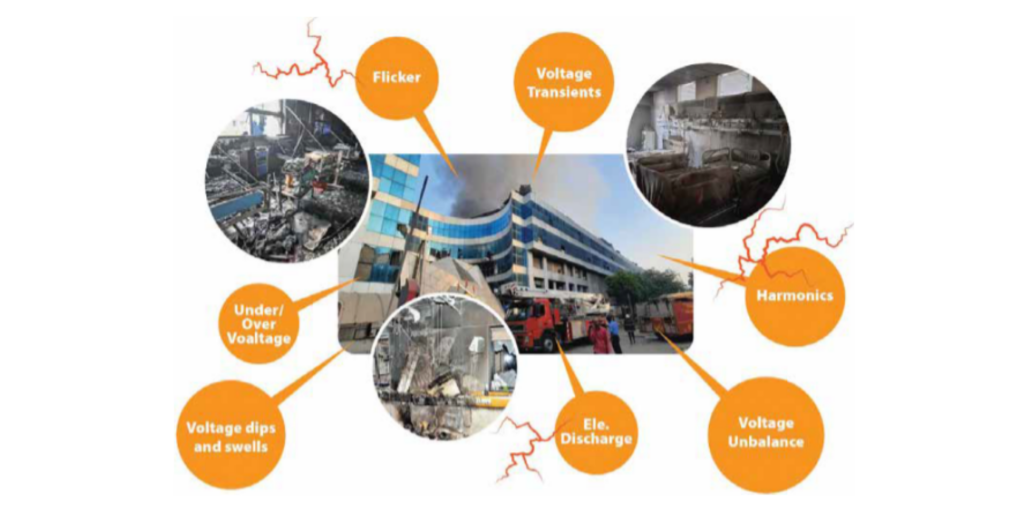
A series of frequent and unfortunate fire incidents in COVID Hospitals has been a cause of concern since the last year. The COVID emergency is not going away soon and all the emergency, infrastructure built to fight the pandemic poses serious risks given its weak foundation. Power Systems are particularly vulnerable given the sudden increase in non-linear loads comprising of ventilators and related medical devices – a crucial defense aid in fighting COVID. With improper electrical systems, further marred by noncompliance to electrical standards and poor workmanship, hospitals are staring at the high risk of weakening the immune systems of their electrical systems and leading to fire!
The pandemic has put stress on the Hospitals like never before. Almost unprepared for the scale and nature of COVID’s medical emergency, it is natural for the Hospital’s Management to prioritize the most urgent and important objective – the treatment of patients. And often, amongst all the essential tasks, it is the minor ones that generally get the least priority and lead to trouble later. Thus, poor Power Quality (PQ) and electrical safety issues are bound to receive less attention in a situation where patients are increasingly struggling for medication and treatment.
But the seemingly minor electrical issues have taken a severe turn and caused a fire in the establishments. Hospitals have been tirelessly operating in the pandemic, TECH INNOVATION AUGUST 2021 | 21 constantly stressed for resources including space, medication, and care. From sports stadiums to hotels, a variety of facilities are being turned into make-shift healthcare facilities.
Given the large-scale problem and short availability of time and resources, very little can be assured for standards and underlying quality of work for the electrical systems. This only means, the risks to the safety and reliability of power systems are higher than ever before. Hospitals are up against yet another hectic and exhausting challenge – ensuring uptime, safety, and proper functioning of all critical devices and systems, mostly driven by electricity, in an extremely challenging situation. Any technical difficulty can become overwhelming for the hospital facility in such a stressed situation.

Power Quality Issues
A Hospital’s critical nature demands extremely careful wiring. The presence of power quality issues, such as high harmonics in the electrical system, is often the root cause of overheating of cables and equipment, further leading to system failures, and in extreme cases, short circuits and instances of fire. This is further accentuated by poor workmanship or poor quality of electrical hardware being deployed under time and financial stress. As Hospitals continually equip themselves to serve more patients, reliable electrical supply must be ensured for the seamless and safe functioning of the facility. Powerhungry electrical equipment such as MRI, CT Scans, X-Ray machines, Ventilators, and other medical devices, used in hospitals need an uninterrupted power supply. A durable cable network is thus absolutely essential to carry this power supply without overheating. However, hospital authorities in India ignorantly prefer low-grade wires in order to save costs which results in overheating, and to add to this PVC used in cables creates a lot of smoke in case of a fire incident. With the addition of Ventilators, air conditioners,high-capacity machines in the ICUs, testing facilities for COVID, the addition of more rooms, and increased use of flammable alcohol-based sanitizers or PPE kits, risks of fire are only going higher. Add to it the poorly designed power systems built with even poorer workmanship, it all works like oxygen to start an electrical fire and feed it further. Hospitals are a very important element of the healthcare system. The emergence of new makeshift hospitals in the current pandemic is well justified but are they complying with the Electrical Safety Standards? The safety and reliability of electrical networks in any building are vital. But in the case of hospitals, it is even more critical.
Building a proactive approach to fire safety
Electrical fire in Hospitals is never a sudden phenomenon or an accident. In fact, it’s a result of a long-time alarm that has kept ringing but has gone unnoticed in the din of other important priorities. But compromised safety of Hospital facilities poses high risks to the reliable conditions for patient care, for COVID, and beyond.
Pay attention to earthing
A common practice in the Indian setup is to use separate earthing connections for all the electronic medical or nonmedical equipment, but it is unjustified. If earthing is not done properly, it may damage the equipment or give electrical shocks to a surgeon or patient. All conductive metal in an equipotential area should be connected to a common equipotential earthing point with a special heavy-duty cable. This reduces the possibility of leakage currents that can cause micro electrocution when the surgeon or patient comes into contact with the equipment.
Ensuring good Power Quality to prevent electrical fire
There are several tools to proactively identify the vulnerabilities in power systems, including power quality issues, much before they lead to extreme events of an electrical fire.
Thermal Imaging is highly helpful in understanding the potential overheating in the electrical network.
Periodic measurements and monitoring of harmonic distortion help in the early identification and prevention of heating in the electrical cables.
Isolation Transformers for sensitive imaging devices or diagnostic equipment.
use of 3+1 Core Cables, owing to their larger surface area, helps in reducing the hot spots, thereby reducing the risk of electrical fires.
Triple Harmonic Filters help to minimize the electrical fire risks emanating in infrastructure with heavy IT/ ITeS, Building Automation with non-linear loads, Computational Infrastructure, UPS Batteries, etc.
Proper Earthing is important to help prevent the hazard in the first place. Here at, Shree Vasudha Gel Earthing we believe and are fully in support of the slogan “ Prevention is better than cure.” We believe in perfection and for that, we always prefer to keep our products towards the aim of customer satisfaction and aim only for their safety.
Conclusion
A proactive approach to fire safety is the only way to ensure foolproof safety of the electrical systems from instances of fire. Hospitals must invest and upgrade their knowledge and experience in resolving the urgent and growing safety concerns on priority. This calls for addressing every root cause – from following the right Standards in cables to improving Power Quality. Proactive prevention of the PQ issues in Hospitals requires much groundwork and addressing the root causes. A course correction from the current practices is required at every stage – from design to installation and maintenance when the facility is in operation. Following high standards and not falling for savings in upfront costs must be the norm. All the hard work, sacrifice, and care in saving the lives of COVID patients cannot be at stake of an increased risk of electrical fire from underlying electrical causes that are fully preventable. Vasudha Gel Earthing is also the Sole and Exclusive Distributor of KALRELighting arrestors in India and also A National Award Winner for Innovation from Productivity by the Council of India.
Vasudha’s Other Products in Earthing solutions are :
- SMART Series Pipe
- PRIME Series Pipe
- V- ECO Series Pipe
- HD Series Pipe
- ROD Series – Regular, Saddle,
- T-Clamp & Vertical Clamp.
- Lighting Arrestors – KALRE &
- MEDITECH ; ESE LA & Traditional.
- Accessories for lighting.
For more information,
Contact :- 9998009989
Email: corporate@vasudhaearthing.com
